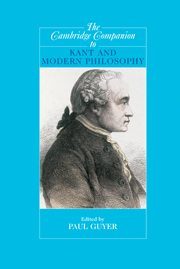Book contents
- Frontmatter
- Introduction: The starry heavens and the moral law
- 1 “A Priori”
- 2 Kant on the perception of space (and time)
- 3 Kant’s philosophy of mathematics
- 4 Kant on a priori concepts: The metaphysical deduction of the categories
- 5 Kant’s philosophy of the cognitive mind
- 6 Kant’s proofs of substance and causation
- 7 Kant and transcendental arguments
- 8 The critique of metaphysics: The structure and fate of Kant’s dialectic
- 9 Philosophy of natural science
- 10 The supreme principle of morality
- 11 Kant on freedom of the will
- 12 Mine and thine? The Kantian state
- 13 Kant on sex and marriage right
- 14 Kant’s theory of peace
- 15 Kant’s conception of virtue
- 16 Kant’s ambitions in the third Critique
- 17 Moral faith and the highest good
- 18 Kant’s critical philosophy and its reception - the first five years (1781-1786)
- Bibliography
- Index
17 - Moral faith and the highest good
Published online by Cambridge University Press: 28 March 2007
- Frontmatter
- Introduction: The starry heavens and the moral law
- 1 “A Priori”
- 2 Kant on the perception of space (and time)
- 3 Kant’s philosophy of mathematics
- 4 Kant on a priori concepts: The metaphysical deduction of the categories
- 5 Kant’s philosophy of the cognitive mind
- 6 Kant’s proofs of substance and causation
- 7 Kant and transcendental arguments
- 8 The critique of metaphysics: The structure and fate of Kant’s dialectic
- 9 Philosophy of natural science
- 10 The supreme principle of morality
- 11 Kant on freedom of the will
- 12 Mine and thine? The Kantian state
- 13 Kant on sex and marriage right
- 14 Kant’s theory of peace
- 15 Kant’s conception of virtue
- 16 Kant’s ambitions in the third Critique
- 17 Moral faith and the highest good
- 18 Kant’s critical philosophy and its reception - the first five years (1781-1786)
- Bibliography
- Index
Summary
PROBLEMS OF INTERPRETATION
Any student who approaches Kant's philosophy of religion for the first time is bound to be daunted by the task. The obstacles are wide, deep, and long. They are wide because Kant thought about virtually every aspect of religion. They are deep because he thought through all these issues with systematic thoroughness and relentless rigor. And they are long because Kant began to think about religious issues as early as the 1760s, and his thinking underwent several transformations through the decades. If these challenges are not enough, Kant's thinking appears in a formidable corpus of writings. His mature religious philosophy is expounded in his three critical works, the Canon of the Critique of Pure Reason, the Dialectic of the Critique of Practical Reason, and the Doctrine of Method of the Critique of the Power of Judgment. The most important mature work, the only one entirely devoted to the philosophy of religion, is his 1793 Religion within the Boundaries of Mere Reason. Apart from these systematic works, there are several important essays of the 1780s and 1790s; there are also the lectures on theology, and last but not least the lectures on ethics, which are crucial for their religious themes.
- Type
- Chapter
- Information
- The Cambridge Companion to Kant and Modern Philosophy , pp. 588 - 629Publisher: Cambridge University PressPrint publication year: 2006
- 46
- Cited by

